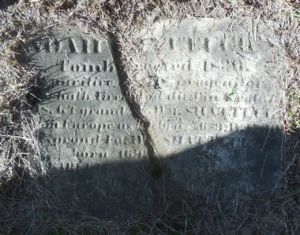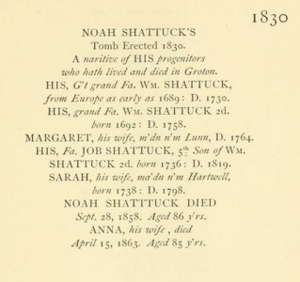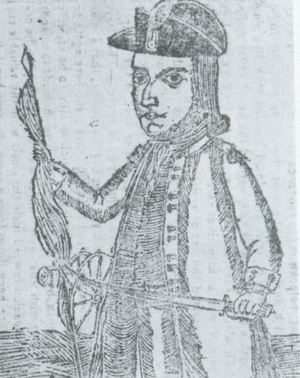Contents |
Biography
Job Shattuck was born 11 Feb 1736 Groton, Middlesex, Massachusetts Bay. He was the son of William Shattuck and Margaret Lunn. He passed away 13 January 1819 in Groton, Middlesex, Massachusetts.
Shattuck was born in the rural central Massachusetts town of Groton in 1736, not long after the final Indian raids and skirmishes that had so often embattled the town during its early colonial period. His family occupied a large tract of land in the northwest corner of town, much of the acreage fronting the banks of the Nashua River. He would eventually become, through ultimogeniture, and his own purchases, the largest landowner in Groton with an estate of approximately 500 acres.
Children
Children, born in Groton: (Mass Vital Records, Groton)
- Job (1758–1827) 10 Dec 1758
- Sarah (1760–1849) 27 Dec 1760
- Ezekiel (1763–1813) 12 Apr 1763
- William (1765–1806) 8 Mar 1765
- Rachel (1767–1816) 12 Jul 1767
- Capt Daniel (1770–1831) 11 Feb 1770
- Noah (1772–1858) 30 Aug 1772
- Margaret (1774–1852) 13 Mar 1774
- Asahael (1778–) 12 Mar 1778
- Anna (1779–1843) 6 Feb 1779
Military
Job Shattuck was a soldier and political leader who lived in Groton, Massachusetts during the 18th century. At the age of 19, he joined the provincial militia as a private in Captain Ephraim Jones's company and took part in the campaign involving the removal of thousands of French settlers in Nova Scotia in 1755. This campaign, known as the Expulsion of the Acadians, was a series of military operations conducted by the British in the colony of Nova Scotia in the mid-1700s. The Acadians were French-speaking settlers who had lived in the region for many generations, but the British considered them a threat to their control of the colony and forcibly removed them from their homes.During the American Revolutionary War, Shattuck responded to the Lexington Alarm, a call to arms issued in response to the Battle of Lexington and Concord in April 1775. He arrived too late to participate in the battle, but continued on to Cambridge for several days and then returned to Groton. While back in Groton, he served on a town committee to assist the Boston poor who had evacuated the city upon the British return.
In the fall of 1775, Shattuck was part of a company of men who went to Boston/Bunker Hill to provide backup as Washington put the Continental Army into place. He returned to Groton, but then went back to Boston to participate in the Siege of Boston, a prolonged military engagement that took place from 1775 to 1776. During the summer of 1776, Shattuck led Groton men to Mt. Independence and Fort Ticonderoga as part of the northern defense. He returned to Groton in December 1776.
During the war, Shattuck was promoted to the rank of Captain by the provincial congress and was also elected town selectman of Groton on three occasions. After the war, he continued to serve in local government and was involved in various civic and community activities in Groton.
| Patriotic Service [1] |
| 1st Lt, Capt Sartell's Co, Alarm of Apr 19, 1775 |
| 1st Lt, Capt. Henry Haskell's co., Col. William Prescott's 10 Regt; Battle of Bunker Hill |
| Commissioned as Capt Jan 1776 |
| 7th Co, Col. John Robinson's Regt; Gen Brickett's Brigade |
| Saratoga Campaign: 2nd Co, Col. Jonathan Reed's 6th Mass Regt from 16 Sep 1776 |
| 1777 he commanded a company raised in Groton and its vicinity. Marched to Ticonderoga at the surrender of Lieutenant General John Burgoyne |
| Member of committee to raise men and funds for the war |
Groton Riots
In October 1781, while serving as town selectman, Shattuck was one of eighteen men obstructing the tax collecting efforts of two constables on three separate occasions, a series of events called the "Groton Riots." In April 1782, he pleaded guilty to rioting and paid a fine of ten pounds. Notwithstanding, townspeople continued to elect him to various positions in local government and as its representative in negotiating benefits on the behalf of soldiers.
Shays' Rebellion
Crippled by debt in the aftermath of the revolution, the state of Massachusetts levied upon its towns and citizens tax burdens higher than had been in place during British rule. Those who suddenly found themselves in arrears to the state quickly discovered that their land, livelihood and possibly even their freedom were at stake. Many who could not assuage their debts faced the unpleasant prospect of serving time in a debtors' prison. The high tax burden, combined with the demand that it be paid in specie and the high-handed control of the government by merchant interests, transformed rural resentment into a full-blown agrarian revolt. The rebellion was waged primarily by debt-ridden western farmers and landowners who banded together and captured shire town courthouses in Massachusetts, closing them to all proceedings. Violence was threatened and enacted against many officials who would not stand down. On a national scale, the rebellion was viewed with intense interest by citizens and public officials of all of the confederated former colonies because it "tested the precarious institutions of the new republic." To officials in Boston, Job Shattuck became, perhaps even more than Daniel Shays, the leader of the agrarians in the western part of the state, a leading firebrand and empathetic advocate of the soldier–farmer who had risked life, limb, and land for the cause of the revolution only to return from the war to find injustice and foreclosure still looming.
Arrest
Charged with treason, on November 30, 1786, Shattuck was harried across the Groton countryside by over 100 men, of whom several were members of the Independent Corps of Cadets from Boston. After they violently searched his home and failed to find him (during which at least one member of his family was injured), they found him on the banks of the Nashua River and took him into custody. He nearly lost his right leg when a cadet slashed it with a sword just above the knee. Shattuck was transported from Groton to Concord and then to Boston and placed into a debtors' cell at the town jail. He was tried, convicted, and sentenced to death by hanging in May 1787, but was pardoned by Governor John Hancock the following September. Shattuck died on January 13, 1819.
Sources
- Mass Vital Records, Groton; 1790 United States Federal Census[2]
- Greens Epitaths from The Old Burying Ground in Groton; Pg 152[3]
- Springfield Technical Community College; Shay's Rebbelion;Job Shattuck[4]
- Lineage Book of the Charter Members of the DAR Vol 067; Pg 71-72
- Massachusetts Soldiers and Sailors of the Revolutionary War (Wright & Potter, Boston, 1896-1908) Vol. 14, p. 24-5
See also:
- Find A Grave: Memorial #84767276 Old Burying Grounds, Groton, Middlesex, MA
- Wikidata: Item Q6206692, en:Wikipedia

- Wikipedia: Job Shattuck
- Daughters of the American Revolution, DAR Genealogical Research Databases, database online, (http://www.dar.org/), "Record of Shattuck, Job", Ancestor # A103088.
- Sons of the American Revolution(SAR) Database; SAR Patriot #: P-287903; State of Service: MA; Qualifying Service: Captain[5]
- 1975 National Geographic Society - People v. Job Shattuck
- 1975 Founder of the Day - Job Shattuck and the Groton Riots
It may be possible to confirm family relationships with Job by comparing test results with other carriers of his Y-chromosome or his mother's mitochondrial DNA. However, there are no known yDNA or mtDNA test-takers in his direct paternal or maternal line. It is likely that these autosomal DNA test-takers will share some percentage of DNA with Job:
-
~0.78%
Colin Foss
 :
AncestryDNA, GEDmatch A514657 [compare], Ancestry member fosscolin
+
MyHeritage DNA
:
AncestryDNA, GEDmatch A514657 [compare], Ancestry member fosscolin
+
MyHeritage DNA
-
~0.39%
Kevin Foss
 :
AncestryDNA, GEDmatch BJ5589297 [compare], Ancestry member kevin_foss1
:
AncestryDNA, GEDmatch BJ5589297 [compare], Ancestry member kevin_foss1
Have you taken a DNA test? If so, login to add it. If not, see our friends at Ancestry DNA.
Featured Female Poet connections: Job is 9 degrees from Anne Bradstreet, 18 degrees from Ruth Niland, 21 degrees from Karin Boye, 24 degrees from 照 松平, 15 degrees from Anne Barnard, 33 degrees from Lola Rodríguez de Tió, 23 degrees from Christina Rossetti, 11 degrees from Emily Dickinson, 27 degrees from Nikki Giovanni, 15 degrees from Isabella Crawford, 18 degrees from Mary Gilmore and 14 degrees from Elizabeth MacDonald on our single family tree. Login to find your connection.
Categories: Seven Years' War | Seven Years' War, British Forces North America | Groton, Massachusetts | British America, French and Indian War | French and Indian Wars | French and Indian War | Old Burying Ground, Groton, Massachusetts | Shays' Rebellion | Minutemen, Militia, American Revolution | Middlesex County Militia, Massachusetts Militia, American Revolution | Notables | NSDAR Patriot Ancestors | NSSAR Patriot Ancestors





